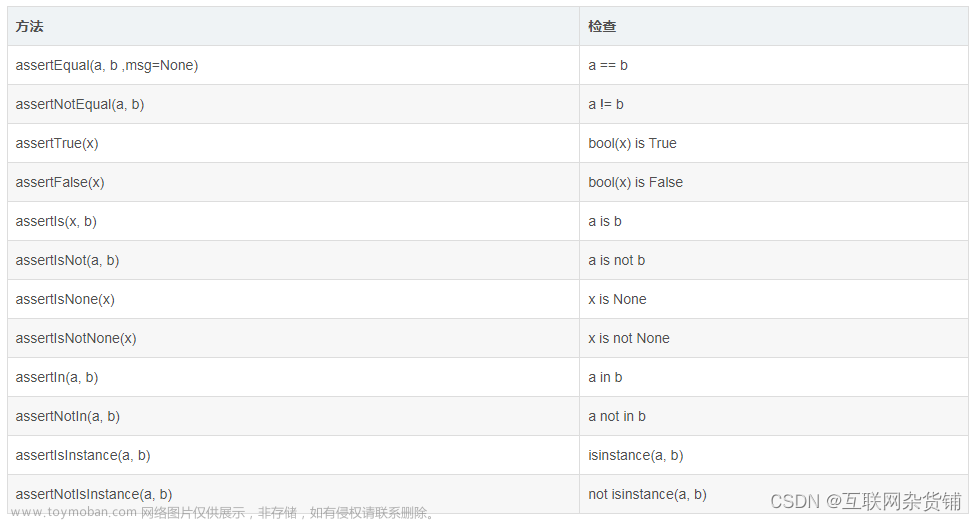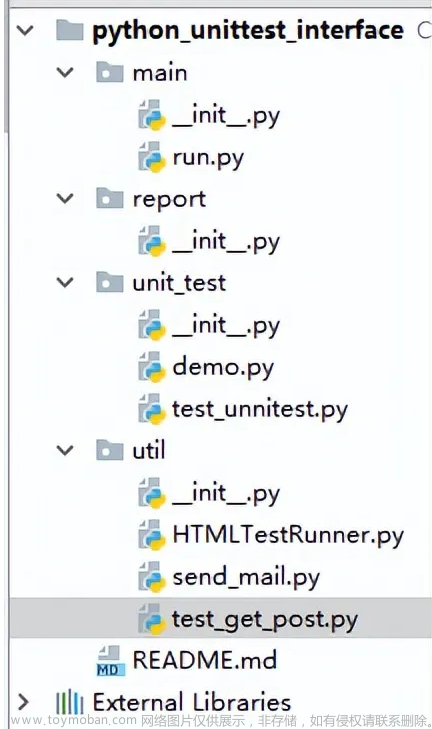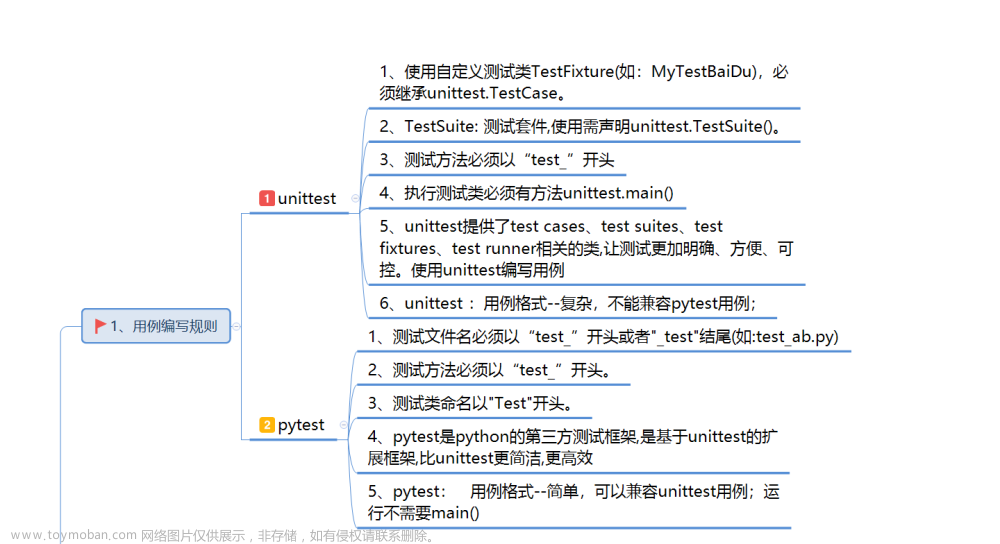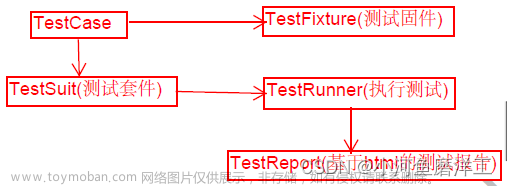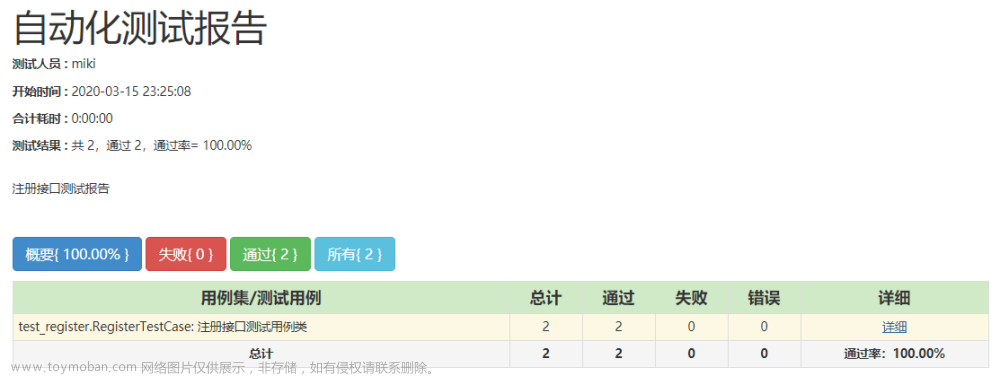test suite
- 测试套件,理解成测试用例集
- 一系列的测试用例,或测试套件,理解成测试用例的集合和测试套件的集合
- 当运行测试套件时,则运行里面添加的所有测试用例
test runner
- 测试运行器
- 用于执行和输出结果的组件
test suite、test runner基础使用
单元测试类
1 # 创建单元测试类,继承unittest.TestCase
2 class testCase(unittest.TestCase):
3
4 # 测试case
5 def test_01(self):
6 print("test01")
7
8 def test_03(self):
9 print("test03")
10
11 def test_04(self):
12 print("test04")
13
14 def test_05(self):
15 print("test05")主函数
1 if __name__ == '__main__':
2 # 实例化测试套件
3 suite = unittest.TestSuite()
4 # 实例化第二个测试套件
5 suite1 = unittest.TestSuite()
6 # 添加测试用例 - 方式一
7 suite.addTest(testCase('test_03'))
8 suite.addTest(testCase('test_01'))
9 suite1.addTest(testCase('test_03'))
10 suite1.addTest(testCase('test_01'))
11 # 添加测试用例 - 方式二
12 testcase = (testCase('test_05'), testCase('test_04'))
13 suite.addTests(testcase)
14 # 测试套件添加测试套件
15 suite.addTest(suite1)
16 # 实例化TextTestRunner类
17 runner = unittest.TextTestRunner()
18 # 运行测试套件
19 runner.run(suite)运行结果
1 test03
2 test01
3 test05
4 test04
5 test03
6 test01
7 ......
8 ----------------------------------------------------------------------
9 Ran 6 tests in 0.000s
10
11 OK包含知识点
- 使用测试套件时,测试用例的执行顺序可以自定义,按照添加的顺序执行
- 有两种添加测试用例的方式,推荐方式二,代码更少更快捷
- ,传入的 tests 可以是list、tuple、set
addTests(tests)
- 添加的测试用例格式是:
单元测试类名(测试用例名)
- 使用测试套件执行测试用例的大致步骤是:实例化TestSuite - 添加测试用例 - 实例化TextTestRunner - 运行测试套件
- 测试套件也可以添加测试套件
测试用例批量执行
单元测试类文件
前三个文件是包含了单元测试类的文件,第四个文件是负责运行所有单元测试类,不包含测试用例
列举某个单元测试类文件代码
1 # 创建单元测试类,继承unittest.TestCase
2 class testCase02(unittest.TestCase):
3
4 # 测试case
5 def test_07(self):
6 print("testCase02 test07")
7
8 def test_06(self):
9 print("testCase02 test06")
10
11 def test_11(self):
12 print("testCase02 test11")test_run.py 代码
批量运行测试用例方式一:
1 import unittest
2 from learn.unittestLearning import test_case02
3 from learn.unittestLearning.test_case03 import testCase03
4
5 if __name__ == '__main__':
6 # 通过模块
7 testcase02 = unittest.TestLoader().loadTestsFromModule(test_case02)
8 # 通过单元测试类
9 testcase03 = unittest.TestLoader().loadTestsFromTestCase(testCase03)
10 # 通过模块字符串
11 testcase04 = unittest.TestLoader().loadTestsFromName('learn.unittestLearning.test_case04')
12 # 测试用例集
13 tests = [testcase02, testcase03, testcase04]
14 # 创建测试套件
15 suite = unittest.TestSuite(tests)
16 # 运行测试套件
17 unittest.TextTestRunner(verbosity=2).run(suite)包含知识点
- :testCaseClass输入单元测试类,但需要先import
loadTestsFromTestCase(testCaseClass)
- :module输入单元测试类所在模块,也需要import
loadTestsFromModule(module, pattern=None)
- :name是一个string,需满足以下格式: module.class.method ,可以只到输入到class
loadTestsFromName(name, module=None)
- :表示测试结果的信息详细程,一共三个值,默认是1
- 0 (静默模式):你只能获得总的测试用例数和总的结果 比如 总共100个 失败20 成功80
- 1 (默认模式):非常类似静默模式 只是在每个成功的用例前面有个 每个失败的用例前面有个 F
- 2 (详细模式):测试结果会显示每个测试用例的所有相关的信息
verbosity
批量运行测试用例方式二(推荐!!):
1 import unittest
2
3 if __name__ == '__main__':
4 # 需要运行的单元测试文件目录
5 test_path = './'
6 # 实例化defaultTestLoader
7 discover = unittest.defaultTestLoader.discover(start_dir=test_path, pattern="test_case*.py")
8 # 运行测试用例集
9 unittest.TextTestRunner().run(discover)优点:是不是简洁。。是不是很快??只需三行代码!!
包含知识点
- :写需要运行的单元测试文件目录
start_dir
- :单元测试文件的匹配规则,默认是 test*.py ,可根据自己的命名规则修改此正则
pattern
- 方法可自动根据测试目录start_dir 匹配查找测试用例文件 test*.py ,并将查找到的测试用例组装到测试套件,因此可以直接通过 run() 方法执行 discover
discover()
批量执行测试用例的结果
1 testCase02 test06
2 testCase02 test07
3 testCase02 test11
4 testCase03 test05
5 testCase03 test08
6 testCase03 test12
7 testCase04 test02
8 testCase04 test04
9 testCase04 test13
10 .........
11 ----------------------------------------------------------------------
12 Ran 9 tests in 0.000s
13
14 OK最后感谢每一个认真阅读我文章的人,礼尚往来总是要有的,这些资料,对于【软件测试】的朋友来说应该是最全面最完整的备战仓库,虽然不是什么很值钱的东西,如果你用得到的话可以直接拿走:

如果你想学习软件测试和需要软件测试资料,欢迎加入扣扣交流群:731789136,里面可以免费领取软件测试+自动化测试资料+软件测试面试宝典+简历模版+实战项目+面试刷题工具和大佬答疑解惑,我们一起交流一起学习!
搜索文章来源:https://www.toymoban.com/news/detail-840695.html
复制文章来源地址https://www.toymoban.com/news/detail-840695.html
到了这里,关于python接口自动化测试 —— unittest框架suite、runner详细使用的文章就介绍完了。如果您还想了解更多内容,请在右上角搜索TOY模板网以前的文章或继续浏览下面的相关文章,希望大家以后多多支持TOY模板网!


